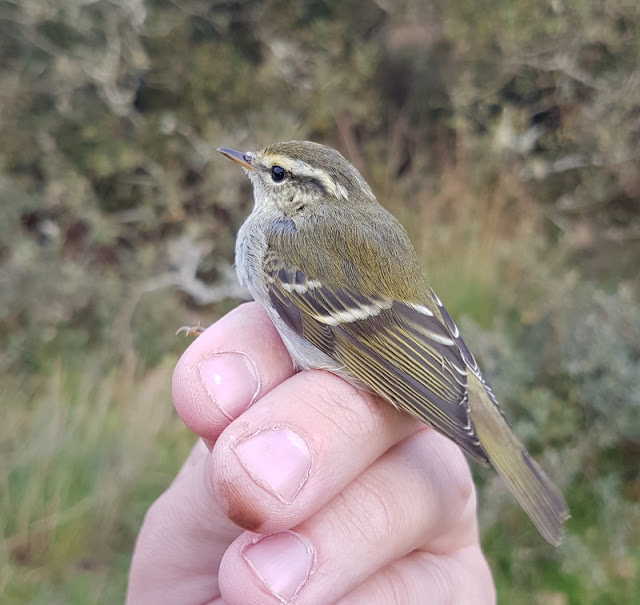After a full on week birding with Bob that has excelled our expectations, it was time for a change of scenery. The wind was calming and my ringing hat started to itch, the Goss Moor was calling! We arrived on the ringing grounds yesterday evening and set some nets ready for first light. There were some interesting birds in the area including Willow and Marsh Tit and several Phylosc's and Crests. I wont lie I struggled to sleep last night in anticipation of the mornings outcome.
We were back bright an early and all nets were unfurled at dawn. It was bitterly cold and there was a heavy covering of frost that we had to contend with. A couple of
Redwing called from nearby so I started to play a Latvian recording on my MP3 speaker but sadly to no avail. I could also hear Crests calling nearby and decided to hedge my bets and started to play this too. This seem to work and the first of 16 entered the net ready for extraction and processing. Also in the early net rounds I managed to pick up a couple of
Chiffchaffs and the first of 2
Blackcaps, one of which was carrying a huge amount of fat ready for the next step of her migration.
 |
| Chiffchaff |
 |
| Juvenile Male Blackcap |
 |
| Juvenile Female Blackcap weighing in at a whopping 23.9 grams |
Then we hit jackpot! A pristine
Yellow-browed Warbler made itself apparent and ready for extraction. I was delighted to get this little gem and enjoyed seeing it at close quarters. Obviously this single bird record doesn't impress as much as the 30+ ringed at Nanjizal in West Cornwall, so far this autumn. However for me it was exciting to get a specimen on my local inland site and on my own ring series. I really hope I get to catch more of them in the future. It was also carrying an incredible amount of fat so I suspect it still wants to travel further afield.
 |
| Yellow-browed Warbler ringed on the Goss Moor |
 |
| Large amount of fat visible |
The morning continued to throw up new birds at a nice steady pace. This was lovely but I have sore fingers now as the most abundant species present was
Blue Tit, finishing the day on a total of 33. The occasional
Robin was also processed including several re-traps that have not been recorded since they were ringed in the same location in September of 2015. This begs the question as to where they spend the summer? And indeed are they coming back from foreign shores? Hopefully a control will help obtain this information in the future.
 |
| Retrap Robin that has been absent since September, 2015. |
 |
| Finger killer in all its glory |
I was beaming after the Yellow-browed capture but another beautiful surprise was waiting for me. A perfect little
Firecrest got in on the act, a first for me at this site. A nice crisp juvenile male strutting its stuff and brightening the already beautiful morning.
 |
| Male Firecrest ringed at the Goss Moor |
As the morning ticked on and lunch time was nearing a
Great-Spotted Woodpecker added interest, even if my ear drums disagree! An adult female that I suspect bred nearby this summer as I heard them often but never had the fortune of meeting at close quarters.
 |
| Female Great Spot doing its best to deafen me! |
The final surprise came in the form of a splendidly cryptic
Treecreeper that graced us with its presence. A delightful example and one that Bob was particularly interested in as he had never seen this species in the hand.
 |
| Treecreeper |
A great days ringing resulting in the following totals:
1 Yellow-browed Warbler, 1 Firecrest, 16 Goldcrest, 1 Treecreeper, 4 Chiffchaff, 4 Wren, 2 Long-tailed Tits, 33 Blue Tits, 4 Coal Tits, 8 Great Tits, 3 Robin, 2 Bullfinch, 2 Blackcap, 1 Chaffinch, 1 Dunnock and 1 Great Spotted Woodpecker. Retraps included:
3 Goldcrest, 3 Robins, and 2 Long-tailed Tits.
 |
| A selection of other ringing participants from today |

Today will always be memorable for me, providing my first ringed Yellow-browed and my first Firecrest on the Goss. I enjoyed the variety and has once again reinforced my passion for this interesting Cornish site.
Tomorrow we are heading to Trevose Head in the morning for some Viz Migging and then around North Cornwall to look for Waders and anything else we can lay our eyes on. Watch this space for an update soon.











 Today will always be memorable for me, providing my first ringed Yellow-browed and my first Firecrest on the Goss. I enjoyed the variety and has once again reinforced my passion for this interesting Cornish site.
Today will always be memorable for me, providing my first ringed Yellow-browed and my first Firecrest on the Goss. I enjoyed the variety and has once again reinforced my passion for this interesting Cornish site.





Good find with the YBW.
ReplyDeleteCheers Steve, the Short-toed Lark was nice... So much potential at St Agnes !
ReplyDelete